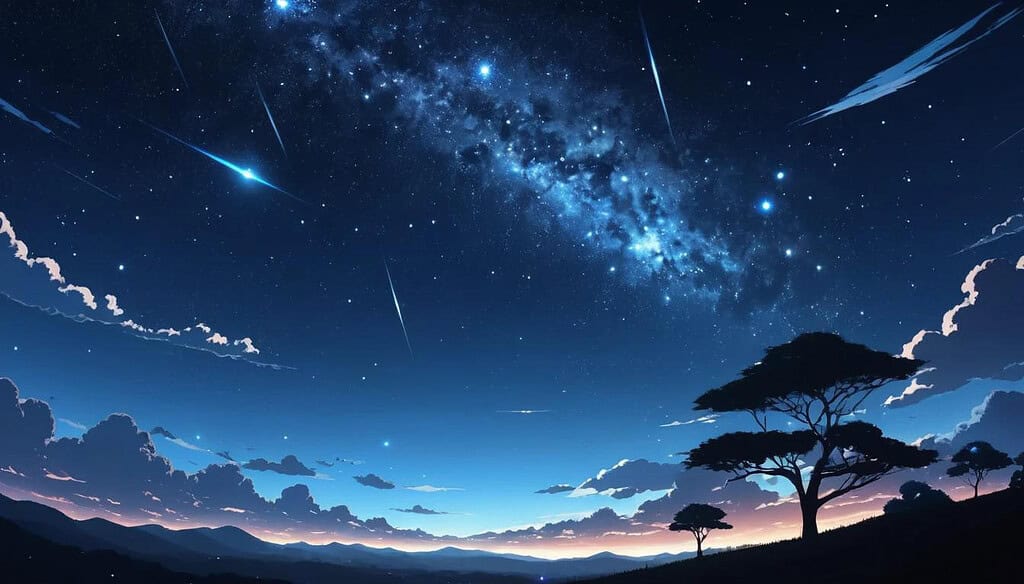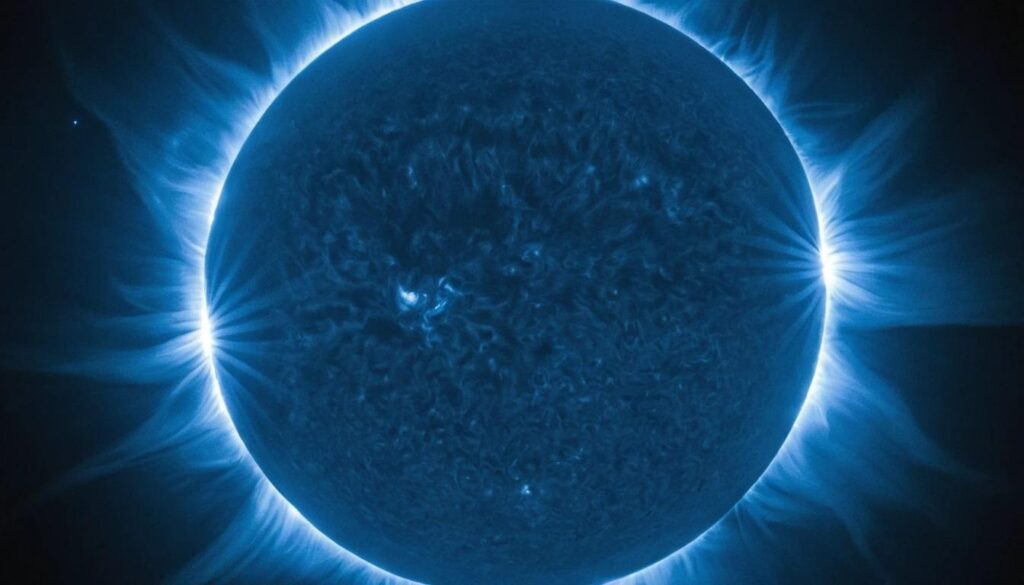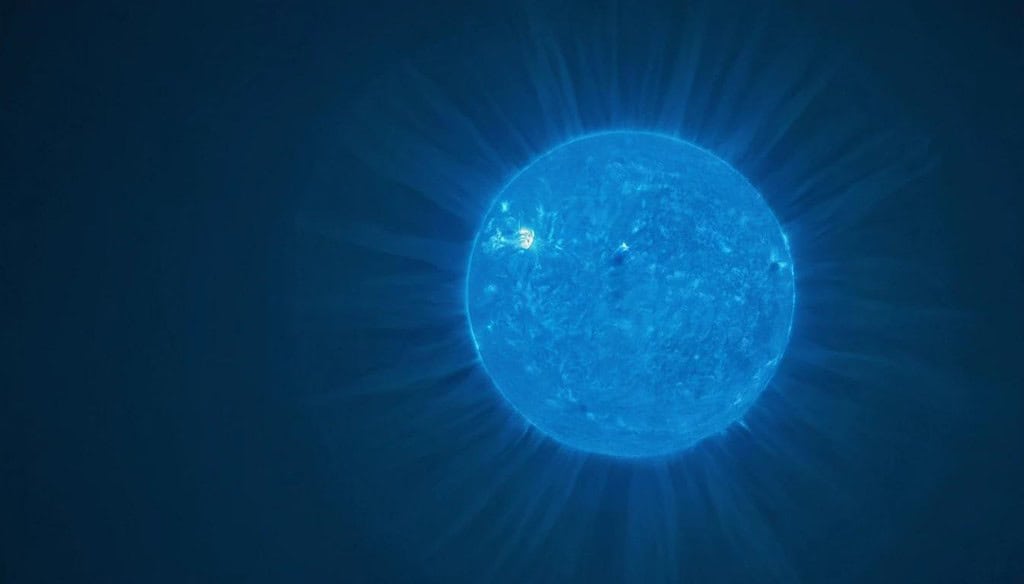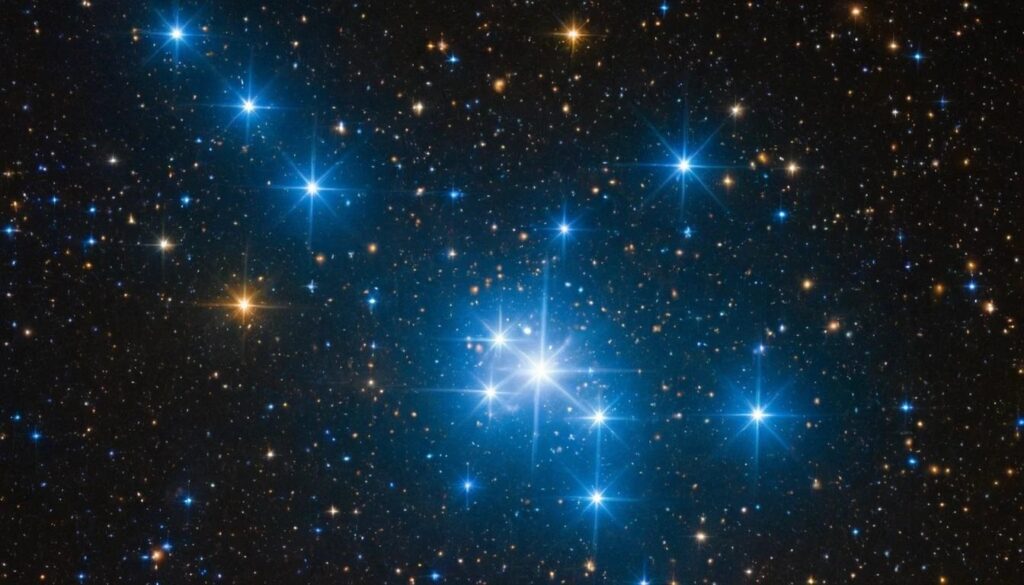Table of Contents
Stars: The Cosmic Creators of Life

Have you ever gazed up at the night sky and thought about how you’re linked to those shining stars? It’s not just a romantic idea; there’s real science behind it. You, me, and everything around us are here because of the stars. These massive celestial bodies are like nature’s alchemists, transforming simple elements into the essential components of life. Without them, we wouldn’t have carbon in our bodies, oxygen in our atmosphere, or iron in our blood.
Stars are the universe’s way of adding complexity to existence. Deep within them, under extreme heat and pressure, they combine hydrogen and helium to create heavier elements. This process, known as nuclear fusion, fuels the stars and produces the vital ingredients for planets, humans, and everything else. As stars grow older, they get even more inventive, creating elements like carbon, nitrogen, and oxygen—key ingredients for our cells and the air we breathe.
But it doesn’t end there. When a massive star reaches the end of its life, it goes out with a spectacular explosion—a supernova. This cataclysmic event spreads those valuable elements throughout the Universe, planting the seeds for new stars, planets, and eventually, life itself. You could say stars are pretty generous, sharing their riches across the cosmos.
What’s truly fascinating is how intertwined we are with this cosmic cycle. The calcium in your bones, the phosphorus in your DNA, and even the silicon in your smartphone all originated in the heart of a star. So, the next time you scroll through your phone or take a sip of water, remember that you’re engaging with the remnants of stellar explosions from billions of years ago.
Think about it: every atom in your body has a story, and it starts in a star. It’s as if the universe spent billions of years crafting the perfect recipe, and we’re the final dish. When you zoom out and see the big picture, it’s humbling. We’re not just living in the universe—we are the universe, in the most literal sense.
So, the next time you see a starry sky, take a moment to appreciate it. Those tiny dots of light are not just celestial decorations—they’re the architects of life, the origin of everything that matters to us. And that’s a story worth telling.
Stars at Work: 8 Essential Elements That Shape Life

1. Carbon: Stars’ Gift to Life’s Framework
Carbon is, quite literally, the backbone of life as we know it. This unassuming element isn’t flashy or rare, but it’s everywhere—woven into the fabric of our existence. From the glucose that fuels your cells to the DNA that carries your genetic code, carbon is the building block for all things living. But here’s the kicker: the carbon in your body wasn’t born on Earth. Its story begins in the fiery interiors of colossal cosmic forges billions of years ago.
Deep inside massive celestial bodies, lighter elements like helium undergo nuclear fusion, forming heavier ones such as carbon. This alchemical process happens under unimaginable pressure and heat, and when these stars reach the end of their lives, they don’t just fade away—they explode. These dramatic supernovae scatter their carbon-rich guts across the cosmos, seeding future generations of planets and life forms.
On Earth, carbon’s versatility is what makes it so extraordinary. With its unique ability to form stable bonds with up to four other atoms, carbon creates the intricate molecules that drive life. All these biomolecules—proteins, lipids, carbohydrates, and nucleic acids—get their intricate structures and functions from carbon. And it’s not just biology. Carbon is the key ingredient in coal, oil, and natural gas—fuels that have powered human civilization for centuries, though they come with their own environmental baggage.
Even the carbon dioxide we exhale plays a role in the global carbon cycle, linking all life forms to a larger ecological rhythm. Think about that the next time you breathe out: you’re releasing a bit of ancient stardust back into the world, continuing a cycle that began long before Earth even existed.
2. Nitrogen: Stars’ Secret to Life’s Chemistry
Carbon serves as the backbone of life, while nitrogen acts as the essential adhesive that binds its chemistry together. Without nitrogen, proteins, DNA, and the cellular energy necessary for life would simply not exist. It plays a fundamental role in biology, working quietly behind the scenes to enable life. Like carbon, nitrogen is a product of the ancient fusion processes occurring in massive stars.
These colossal stars create nitrogen atoms by fusing lighter elements in their intense cores. When they reach the end of their life cycle and explode, they scatter nitrogen throughout the cosmos. Over millions of years, this nitrogen travels through space, eventually becoming part of the planets and ecosystems that support life.
However, nitrogen presents a bit of a puzzle. Although it constitutes about 78% of Earth’s atmosphere, most living organisms cannot utilize it in its gaseous state. Picture a pantry filled with food that you can’t access—it’s there, but locked away. This is where nitrogen fixation comes into play. Certain soil bacteria break down nitrogen gas, transforming it into forms that plants can take up. Once absorbed by plants, nitrogen ascends the food chain, becoming the proteins and nucleic acids that nourish animals, including humans.
Nitrogen’s significance extends beyond biology; it is also vital for the natural processes that sustain ecosystems. For instance, farmers depend on nitrogen-rich fertilizers to cultivate crops, but managing this resource requires care. Excess nitrogen can upset the balance of ecosystems, leading to problems like algae blooms in aquatic environments. Nevertheless, nitrogen remains essential, influencing everything from cellular functions to the overall health of ecosystems.
3. Oxygen: The Life-Giving Breath from Stars
Oxygen is essential for life, playing a crucial role in the narrative of existence on Earth. It fills the air we inhale, the water we consume, and the energy cycles that sustain us. However, its remarkable journey starts far beyond our planet, within the blazing cores of dying stars.
Inside these celestial giants, nuclear fusion creates oxygen from lighter elements. When these stars reach the end of their life cycle and explode in brilliant supernovae, they disperse oxygen throughout the universe. Some of this oxygen eventually reaches planets like Earth, becoming a vital component of our planet’s chemistry and biology.
On Earth, oxygen is indispensable. It powers cellular respiration, the process through which cells transform food into energy. Without oxygen, complex life forms such as animals could not survive. Moreover, oxygen is crucial for the formation of water, the very molecule that supports life on our planet.
Another intriguing aspect of oxygen is its evolution on Earth. In the planet’s early days, the atmosphere was nearly devoid of oxygen. It wasn’t until microscopic organisms began the process of photosynthesis that oxygen levels began to rise. This Great Oxidation Event dramatically changed Earth, allowing for the emergence of complex, oxygen-reliant life forms.
Today, oxygen is a fundamental element in both ecosystems and industries. It nurtures marine life in the oceans and fuels combustion engines on land. Whether you’re enjoying a refreshing breath during a hike or powering the machinery that constructs skyscrapers, oxygen’s influence is everywhere. Each breath we take serves as a reminder of its cosmic beginnings, connecting us to the ancient processes that formed the universe.
4. Sodium: Stars’ Spark for Earth’s Balance
Sodium might not grab headlines like carbon or oxygen, but it’s a quiet yet vital player in the drama of life. This soft, silvery metal isn’t just sitting idly in the Earth’s crust; it’s busy helping maintain balance, both inside living organisms and across the planet itself. The sodium that flows in your bloodstream or helps plants absorb nutrients in the soil started its journey billions of years ago in the core of massive celestial bodies.
Like many other elements essential to life, sodium is born in the extreme heat and pressure of stellar interiors. Through nuclear fusion, these fiery forges create sodium from lighter elements, and when they eventually reach the end of their lives, they release this element into space in grand, explosive finales. Once scattered into the cosmos, sodium becomes part of new solar systems, where it finds its way into planets like Earth.
Here, sodium plays a surprisingly dynamic role. In your body, sodium ions zip through your nerves and muscles, creating the electrical signals that allow you to move, think, and react. It’s the element that keeps your heart beating steadily and your muscles contracting smoothly. Without sodium’s careful balancing act, our cells wouldn’t function properly.
Sodium’s importance isn’t limited to biology. On a planetary scale, it’s an integral part of the salt found in Earth’s oceans. Sodium combines with chlorine to form the sodium chloride we know as table salt, a substance that’s been essential for both human survival and civilization’s growth. Beyond seasoning food, salt has preserved meals, driven trade, and even been used as currency in ancient societies.
The element also shapes Earth’s chemistry. Sodium is a key player in minerals like feldspar, which make up much of the Earth’s crust. These minerals influence the structure of rocks and landscapes, silently shaping the world around us. So whether it’s helping your brain send a signal or giving the ocean its familiar taste, sodium is quietly indispensable.
5. Magnesium: Stars’ Touch of Strength
Magnesium isn’t just about making fireworks burn brightly or adding a little flair to chlorophyll. It’s an elemental powerhouse that combines strength and utility, contributing to everything from the bones in your body to the stability of our planet. And like sodium, its story starts in the violent, blazing interiors of massive stars.
In these cosmic cauldrons, lighter elements fuse to form heavier ones, with magnesium being one of the outcomes of this stellar alchemy. When these celestial giants end their lives, they scatter magnesium across the galaxy, seeding planets like Earth with this essential element.
Magnesium’s role in life is multifaceted. In plants, it sits at the center of the chlorophyll molecule, allowing plants to capture sunlight and perform photosynthesis. Without magnesium, there’d be no way for plants to convert sunlight into energy, and by extension, no food chains, no oxygen, and no life as we know it.
In humans, magnesium is equally indispensable. It helps your body produce energy, supports muscle and nerve function, and contributes to the structure of bones and teeth. The magnesium in your morning spinach smoothie or multivitamin is directly linked to the ancient processes of nucleosynthesis in stars.
But magnesium isn’t just confined to biological processes. On Earth, it’s a key component of many minerals, including dolomite and magnesite. These minerals contribute to the formation of rocks and landscapes, playing a subtle yet critical role in Earth’s geological cycles. Magnesium is also used in lightweight alloys that are essential in industries like aerospace and automotive manufacturing, where strength and lightness are critical.
Everywhere you look, magnesium is adding strength and stability, whether it’s in the green of a leaf, the bones of your body, or the materials of modern technology.
6. Silicon: Stars’ Architect of Earth and Technology
Silicon is the quiet architect of both our planet and our modern world. This element, forged in the cores of aging stars, has a dual role—building the physical structure of Earth and enabling the technological marvels we rely on every day. It’s not an exaggeration to say that silicon has shaped life in ways both ancient and cutting-edge.
Like sodium and magnesium, silicon begins its story in massive celestial interiors. Through nuclear fusion, stars create silicon from lighter elements, and when these stars end their lives, they distribute this element across the universe. Silicon eventually became a fundamental part of Earth’s crust, forming minerals like quartz, feldspar, and mica. These minerals shape the very ground we walk on, creating the mountains, valleys, and sand beneath our feet.
Silicon’s contributions don’t stop with rocks and landscapes. It’s a major ingredient in clay, which humans have used for thousands of years to create pottery, bricks, and even early writing tablets. Fast-forward to today, and silicon is still indispensable, though now it plays a starring role in our technological revolution.
If you’re reading this on a smartphone, computer, or tablet, you can thank silicon. Its unique properties make it ideal for use in semiconductors, the tiny chips that power modern electronics. Silicon is the backbone of the tech industry, enabling everything from laptops to solar panels. It’s the reason we can communicate instantly, navigate with GPS, and harness renewable energy.
Even in biology, silicon makes a quiet impact. Some microscopic organisms, like diatoms, use silicon to build their intricate skeletons. Over millions of years, the remains of these organisms have contributed to the formation of silica-rich rocks and sands, continuing silicon’s legacy of shaping our planet.
Silicon is a testament to how an element born in the heart of stars can go on to create the world we live in, from the natural landscapes we admire to the technology we depend on. Whether it’s forming a towering mountain or powering the chip in your smartphone, silicon is everywhere, silently working behind the scenes to make life on Earth what it is today.
7. Phosphorus: Stars’ Key to Life’s Code
Phosphorus might not get the spotlight like carbon or oxygen, but it’s an unsung hero in the story of life. This element, birthed in the violent deaths of massive stars, is a cornerstone of biology and an essential ingredient in the molecules that define us. Without phosphorus, there’d be no DNA to carry our genetic code, no ATP to power our cells, and no way for life to function as we know it.
Phosphorus begins its journey in the cores of massive celestial bodies. These stars, burning through their nuclear fuel, forge heavier elements like phosphorus. When their time comes to an end in colossal supernova explosions, they scatter this precious material into the cosmos. Over time, these fragments of stardust become part of new solar systems, where they find their way into planets like Earth.
On our planet, phosphorus becomes part of the cycle of life. It’s embedded in rocks and minerals, slowly released into the soil and water through natural processes like weathering. Plants absorb phosphorus, turning it into the building blocks of life. From there, it makes its way up the food chain, becoming part of every living organism.
Phosphorus is perhaps best known for its role in DNA and RNA, the molecules that store and transmit genetic information. It forms the backbone of these structures, linking together the nucleotides that encode life’s instructions. But that’s not its only role. Phosphorus is also a key component of ATP, the molecule that cells use to store and transfer energy. Every time you take a step, blink, or even think, phosphorus is helping make it happen.
Beyond its biological significance, phosphorus has shaped human civilization. Early agricultural societies relied on phosphorus-rich fertilizers to grow crops, and even today, modern agriculture depends on it. Without phosphorus, the global food supply would be in jeopardy. Yet, like all finite resources, it must be carefully managed to ensure it lasts for generations to come.
8. Iron: The Core of Stars and Civilizations
Iron is everywhere—beneath your feet, coursing through your veins, and holding up the skyscrapers that define modern cities. But the iron we see and use today didn’t originate on Earth. Its story is one of cosmic proportions, beginning in the last stages of a star’s life.
In the fiery cores of massive stars, nuclear fusion creates progressively heavier elements. Iron is the endgame. Unlike lighter elements, the creation of iron doesn’t release energy; it absorbs it. This marks the star’s impending collapse. When these giants finally die, they erupt in supernova explosions, spreading their iron-rich guts across the universe. Some of that iron eventually ends up here on Earth, becoming part of the planet’s core, crust, and life itself.
Iron plays a critical role in biology. It’s a central component of hemoglobin, the protein in red blood cells that carries oxygen throughout your body. Without iron, your cells wouldn’t get the oxygen they need to function. That’s why iron is so vital to health and why it’s a cornerstone of nutrition. It’s also found in enzymes and proteins that drive essential processes in your body, from energy production to DNA synthesis.
On a planetary scale, iron is just as impactful. The Earth’s core is rich in molten iron, creating the magnetic field that shields us from harmful solar radiation and makes life possible. Above the core, iron is a key component of the planet’s crust, found in minerals like hematite and magnetite. These iron-rich rocks have been mined and used by humans for millennia.
Iron’s importance in human history can’t be overstated. It defined entire ages, from the tools and weapons of the Iron Age to the steel beams of modern architecture. Its strength, abundance, and versatility have made it a cornerstone of civilization. Trains, ships, buildings, and countless everyday objects owe their existence to iron.
From the core of stars to the foundations of cities, iron is a bridge between the cosmic and the earthly. It’s a reminder of how deeply connected we are to the universe, with its story written into the very framework of our lives and civilizations.
Stars in Action: Connecting the Cosmos to Our World

The influence of stars doesn’t end with the elements they’ve gifted to Earth. Their handiwork continues to shape our world, fueling both our understanding of the universe and our technological leaps forward. From the origins of planetary systems to humanity’s daring attempts to replicate the processes happening in their fiery cores, stars remain central to the story of progress.
When we look at modern technology, the fingerprints of stars are everywhere. Take solar panels, for instance. They harness energy from the Sun—a modest star compared to its cosmic siblings—transforming light into electricity to power homes and gadgets. It’s essentially our way of borrowing a star’s energy, neatly packaged and delivered to our devices. The tech we rely on daily, like semiconductors in electronics, also owes its existence to silicon, an element forged in ancient stellar interiors. Without stars, much of what powers modern life wouldn’t exist.
Stars also help us trace our origins in more profound ways. Observing other planetary systems forming around young stars gives us clues about how Earth and its neighbors came to be. These distant systems provide snapshots of the past, revealing the chaotic dance of dust and gas that eventually led to planets, moons, and everything else in between. Understanding these processes not only satisfies our cosmic curiosity but also helps refine the search for Earth-like planets that might harbor life.
Perhaps the most ambitious connection we’ve forged with stars lies in our quest to mimic their power. Nuclear fusion, the process that fuels stars, has long been humanity’s dream for clean, limitless energy. Unlike nuclear fission, which splits atoms, fusion combines them, creating immense energy without producing harmful waste. It’s the ultimate power source, but taming it has proven to be one of science’s most formidable challenges. Yet, every step forward in this endeavor brings us closer to tapping into the same force that lights up the cosmos.
Stars are more than distant points of light; they’re active participants in our story. They’ve shaped our past, influenced our present, and inspire our future. Whether it’s understanding the universe, crafting technology, or chasing the dream of fusion power, stars remind us that we’re forever linked to the cosmos.
Stars: The Eternal Architects of Life

It’s wild to think about, isn’t it? The atoms in your body—those that make up your bones, your blood, even your thoughts—were once part of ancient stars. We owe everything to these celestial giants. They aren’t just bright specks in the night sky; they’re architects, crafting the elements that make life possible and shaping the very fabric of existence.
Stars are where the story begins. In their fiery cores, under pressure and temperature, we can hardly fathom, simple atoms fuse to create the heavier elements that life depends on. When these stars reach their spectacular ends, they scatter their creations across the cosmos, planting the seeds for new worlds and new possibilities. It’s a cycle of destruction and renewal that’s both violent and beautiful.
Here on Earth, we are living proof of their handiwork. The carbon in your cells, the oxygen in your lungs, the calcium in your bones—all of it came from stars. Even the iron coursing through your veins, carrying oxygen to your cells, owes its existence to their incredible alchemy. This connection isn’t poetic—it’s a scientific fact, one that ties us to the universe in ways that are both humbling and awe-inspiring.
But stars don’t just stop at giving us the raw materials. They shape the environments where life can flourish. By producing energy and light, they warm planets, spark chemical reactions, and drive the processes that turn barren rocks into vibrant ecosystems. Without stars, Earth would be a cold, dark, and lifeless place, adrift in a silent cosmos.
Our relationship with stars doesn’t end there. They also fuel our curiosity, pushing us to look beyond our world and ask big questions about where we come from and where we’re going. They inspire myths and art, guide sailors across oceans, and now, with telescopes and spacecraft, help us explore the very edges of existence.
In the grand scheme of things, we’re just tiny pieces of an ancient puzzle, created by stars and destined to return to the cosmos someday. That might sound daunting, but it’s also incredibly beautiful. It means that no matter how small or fleeting our lives might seem, we’re part of something infinite, woven into the grand, ongoing story of the universe.
Disclaimers: *This article is only for informational purposes.
**Do not make your important decisions solely based on the information provided in this article. Do your own research.
***Information in this article may vary or get updated in the future.
Read More Science and Space Articles
- 8 Remarkable Ways Kumquat Shines in Culture and Cuisine
- Beautiful Art of Gravity: 8 Ways It Shapes Our Daily Lives
- Big Bang: 8 Explosive Steps to Derive The Recipe of Cosmos
- 8 Amazing Lime Tales: Ancient Groves to Modern Kitchens
- 8 Weird Ways Grapefruit Can Interfere with Medications
- Pomelo in Culture: 8 Heartwarming Ritual Traditions
- 8 Culinary Uses of Oranges That I Highly Recommend
- 8 Astounding Ways Lemons Have Helped Elevate My Mood
- 8 Irresistible Ericaceae Fruits (Heath Family) to Savor and Enjoy
- 8 Incredible and Healthy Cucurbitaceae Fruits to Enjoy
- Top 8 Delicious Anacardiaceae Fruits You Must Try
- 8 Incredible Musaceae Fruits You Need to Try Right Now
- 8 Incredible Vitaceae Fruits: Nature’s Tasty Treasures
- 8 Incredible Rosaceae Fruits You Need to Discover
- Discover 8 Fruit Families That Enrich Our Daily Diets
- 8 Non-CO₂ Greenhouse Gasses That Are Worst Than CO₂
- 8 Ways Water Crisis is Worsened by Global Climate Change
- 8 Amazing Ways Brain Anatomy is Altered by New Learning
- 8 Disastrous Ways Deforestation Destroys Biodiversity
- 8 Worst Ways Global Climate Change Hurts The Impoverished
- Danger Of Environmental Damage: 8 Ways A Person Can Help
- Eradication Of Poverty: 8 Critical Ways Science Helps
- Mathematics: 8 Interesting Ways To Become Efficient At It
- STEM Fields: 8 Important Reasons Why You Must Learn Them
- Making Your Kid Efficient At STEM Subjects: 8 Important Steps
- Becoming A NASA Aspirant: 8 Important Steps You Must Follow
- Discoveries by JWST: 10 Incredible Findings of The Telescope
- NASA’s MOXIE Creates O2: Big Step Towards Mars Colonization
- Space Science: 6 Vital Reasons Why We Should Invest in It
- Solar System: 10 Astonishing Uniqueness of our star system




